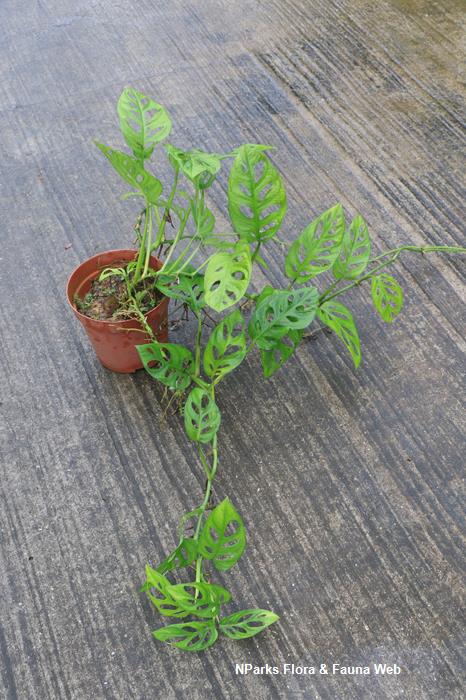
Name
Classifications and Characteristics
| Plant Division | Angiosperms (Flowering Seed Plants) (Monocotyledon) |
|---|---|
| Plant Growth Form | Climber, Herbaceous Plant |
| Lifespan (in Singapore) | Perennial |
| Mode of Nutrition | Autotrophic |
| Plant Shape | Irregular |
Biogeography
| Native Distribution | Tropical America |
|---|---|
| Native Habitat | Terrestrial |
| Preferred Climate Zone | Tropical |
| Local Conservation Status | Non-native (Horticultural / Cultivated Only) |
Description and Ethnobotany
| Foliage | Leaves are green with entire leaf margin and long petiole (5 – 15 cm long). Leaf shape are variable, ranging from lanceolate (35 cm long 4 cm wide) to broadly ovate (14 cm long and 12 cm wide). Matured leaves are perforated by conspicuous holes on each side of the midrib. Leaf base is unequal, with one side about twice as wide as the other. |
|---|---|
| Stems | Stem is green and cylindrical, about 2 – 10 mm in diameter. Stem have internodes about 10 – 30 cm long and occasionally produce stolons. |
| Flowers | Tiny flowers are borne on a spike called spadix and surrounded by a modified leaf called spathe; together forming an inflorescence. Spathe is green and turns bright yellow when matured, usually 4 – 7 cm long and 3 – 5 cm wide. Flowering spadix is green and turns dark yellow (5 – 10 mm thick and 2 .5 – 6 mm long) when matured. Fruiting spadix turns from green to dark orange when matured. |
| Fruit | Fruits are white and berry-like, about 5 – 8 mm in diameter. |
| Similar | Similar to Monstera adansonii, however the juvenile plant of M.obliqua has distinctive fenestrated leaf blades. M.adansonii leaves are thicker and more membranous. |
| Etymology | The genus epithet 'Monstera' is derived from 'monstrum', meaning of huge size or monstrous foliage. The specific epithet 'obliqua' means slanting, unequal-sided, with reference to the leaf. |
Landscaping Features
| Desirable Plant Features | Ornamental Foliage |
|---|---|
| Landscape Uses | Interiorscape/ Indoor Plant |
Plant Care and Propagation
| Light Preference | Semi-Shade, Full Shade |
|---|---|
| Water Preference | Lots of Water |
| Plant Growth Rate | Fast to Moderate |
Foliar
| Foliage Retention | Evergreen |
|---|---|
| Mature Foliage Colour(s) | Green |
| Mature Foliage Texture(s) | Thin |
| Prominent Young Flush Colour(s) | Green |
| Young Flush Texture(s) | Thin |
| Foliar Type | Simple / Unifoliate |
| Foliar Arrangement Along Stem | Alternate |
| Foliar Attachment to Stem | Petiolate |
| Foliar Shape(s) | Non-Palm Foliage (Asymmetrical) |
| Foliar Venation | Pinnate / Net |
| Foliar Margin | Entire, Entire - Wavy / Undulate |
| Foliar Apex - Tip | Acuminate |
| Foliar Base | Oblique / Asymmetrical |
Floral (Angiosperm)
| Flower Grouping | Cluster / Inflorescence |
|---|---|
| Inflorescence Type | Spathe & Spadix |
Fruit, Seed and Spore
| Mature Fruit Colour(s) | White |
|---|
Image Repository
Others
| Master ID | 159 |
|---|---|
| Species ID | 1455 |
| Flora Disclaimer | The information in this website has been compiled from reliable sources, such as reference works on medicinal plants. It is not a substitute for medical advice or treatment and NParks does not purport to provide any medical advice. Readers should always consult his/her physician before using or consuming a plant for medicinal purposes. |






.jpg)
.jpg)